Clean freaks, germaphobes, and perfectionists, I have great news for you. There is a way to get your laundry cleaner than it has ever been.
It’s called “stripping” your laundry, and while it takes forever, it is also surprisingly easy.
If you’ve ever used cloth diapers, you’re likely to have heard of this stripping process before. Essentially, it’s a way to clean the living heck out of a material by soaking it in super-hot water and various cleansing agents. By stripping your laundry, you remove any residue from soap, laundry detergent, and fabric softener. You also remove mineral buildup from hard water, as well as any general ickiness that has built up in the fabric over time.
Stripping your laundry could be necessary if:
- You’ve been using a gentle, homemade laundry soap rather than detergent for a long time — especially if you’ve been using that soap on items that need to be absorbent, like diapers or towels. Homemade laundry soap can be great, but it also poses certain problems.
- You live in an area with hard water.
- You relish the idea of checking out how much leftover grossness you can remove from your laundry in one sitting.
But truthfully, stripping your laundry can be a useful practice for anyone, regardless of how you normally clean your things. It helps you determine just how clean your laundry is really getting, and it “resets” your laundry to a blank slate. And, no less important, it is oddly satisfying.
I wanted to strip my sheets mostly out of morbid curiosity. I first discovered the concept of stripping your laundry when I was making DIY laundry soap for the first time. It immediately made me wonder what would happen if I stripped my sheets, which I wash once every week or two, usually with regular detergent, in a city with quite hard water.
I sleep on those things every night, after all. If they’re getting super gross despite regular laundering, I need to know — and take photos and show everyone. Gotta love a photo of nasty laundry water!
Stripping my sheets took about seven hours total, but don’t let that scare you. Most of that time was spent just waiting around.
Would you, too, like to see how gross your laundry really is? Great! Let’s begin.
Stripping Laundry: What You Need
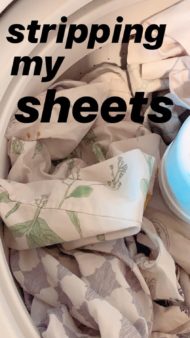
To get started with stripping your laundry, you need to get your hands on some strippers (haha). OK, the real term is “mineral-removing solution.” These products are available at the store or online. Alternatively, you can make a solution yourself.
If you’d like to buy your solution, try GroVia Mighty Bubbles.
If you’d like to make your own, you can use a combo of washing soda, borax, and/or Calgon along with regular laundry detergent with enzymes.
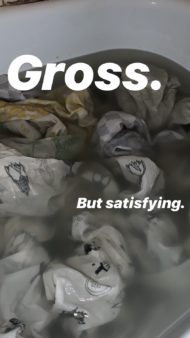
Lastly, you need some laundry. Preferably some laundry that could really use a good cleaning, like your kid’s baseball uniform, your workout clothes, used clothes from the thrift store, or — like me — your sheets.
1. Start with clean laundry.

You must start with CLEAN laundry, not dirty. We’re looking to go a step beyond regular laundering, so we’ll wash the laundry first, then strip the clean laundry. If your laundry is already clean, no need to rewash it.
You will be soaking the laundry after you wash it, so there’s also no need to toss it into the dryer.
2. Fill a tub with extra-hot water and stripping solution.
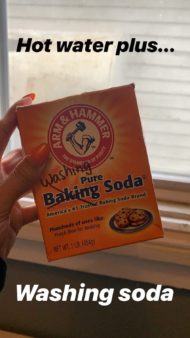
You can use the bathtub, a large bucket, or a top-loader washing machine for this process. Fill the container with very hot water — not boiling, but as hot as the water will get from the tap. Fill your chosen container with enough water to fully cover the laundry.
Then add your stripping solution.
I decided to go the DIY route, since I already had two of the three items from when I made laundry soap.

I added 1/4 cup of washing soda and 1/4 cup of borax.
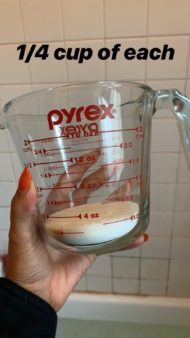
And then I added 1/2 cup of laundry detergent.

I dissolved each ingredient in the bathtub.

Ready to go!
3. Add laundry to soak.

Dunk your laundry in the solution. Let it soak for four hours, or until the water is cool to the touch.
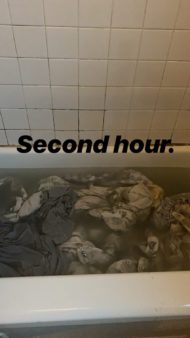
very hour or so, check on the laundry, stir it around, and take a photo to track how gross the water is! Woo.

The water will probably get grosser as time goes on. Depending on your situation, it might turn colors or even develop a smell.
From what I’ve seen on the internet, it could turn completely brown and smell like something decaying and make you wonder what sort of filth you’ve been living in. This is normal. Do not panic.

In my case, the above photo is the grossest it got, really.
The water turned dark gray but didn’t develop any obscene smell, which I have to admit was a little disappointing — although I probably should have been relieved!
4. Rinse again.

After four hours, you can drain the icky water from the tub and wring the items out.
Then put them into the washing machine and wash them again, but this time on a WATER-ONLY cycle — no detergent! This will help get any remaining minerals and buildup off the fabric.
5. Dry and enjoy.
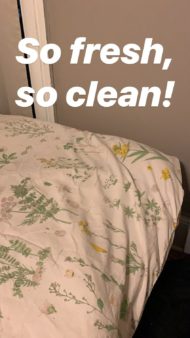
That’s it! Dry your laundry, marvel at how clean it is, and go to sleep — because this process took longer than you expected, and now it’s late and you’re exhausted.
In conclusion, my water didn’t get quite as dirty as some of the photos I’ve seen on the internet. That led me to conclude that my sheets weren’t as gross as I worried, which is good news. Still, the water was definitely gray, and there is plenty of grossness in the water that we cannot see with our bare eyes.
And I have to say — my sheets felt really clean. Sleeping on stripped sheets made me feel like a pure baby angel. To me, this process was definitely worth the lengthy endeavor.
Realistically, I’ll probably do this again in exactly 10 years and not a day sooner, but that’s because I am lazy. I do fully recommend it, if it appeals to you. But don’t do it too often — this process is harsh on your laundry, so it’s not wise to do it for every load.













